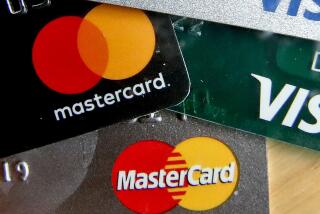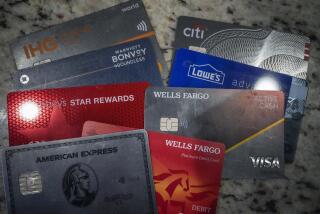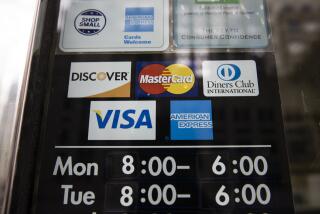Small Banks Do Big Business in Low-Interest Credit Cards : Finance: Major issuers respond to market share loss by cutting rates for their best customers and promoting extra services.
- Share via
NEW YORK — First came micro-breweries, which made inroads into the beer market by selling small batches of premium beer. Now come “micro-issuers”--small credit card companies in small towns that are nipping at the heels of big banks by offering low rates to top customers.
Led by Simmon’s Bank of Pine Bluff, Ark., which charges customers just 8% on their balances, low-rate credit cards have become one of the industry’s fastest-growing segments.
Their secret: Eschew costly advertising blitzes, cut overhead to a bare minimum and limit business to customers with the best credit records.
“The big issuers are smarting from these micro-issuers. They not only are losing market share, but they’re having to cut rates to their best customers,” said Robert B. McKinley, president of RAM Research Corp. in Frederick, Md., which tracks the credit card industry nationwide.
Industry leader Citibank, for example, saw its outstanding balances grow by just 1.4% over the first six months of this year. On average, the accounts of the top 10 bank credit card issuers grew by 5.5% last year.
In contrast, Simmon’s Bank saw its accounts surge 47% between January and June, while low-rate issuers as a whole saw business increase 8.9%.
In response to this cut-rate challenge, the big issuers are tucking in their rates and offering more services. Citibank recently offered a promotional 9.9% interest rate and has started a two-tiered rate system, with preferred customers paying 15.4% and regular customers paying 19.8%.
The bigger issuers are also stepping up promotions of side benefits, such as auto insurance and purchase protection.
Still, the interest rate on most bank credit cards remains high. The national average is 17.22%, down less than one percentage point from last fall, while the average annual fee is $16.80, down 40 cents, according to RAM Research.
Banks like AFBA Industrial Bank in Alexandria, Va., however, offer 8.9% and no annual fee, highlighting the advantages of holding a card issued by one of the smaller banks.
A Catch-22 for beleaguered credit card holders is that many who most need the cheap cards can’t get them. About 70% of applicants for these cards get rejected, said Ruth Susswine of Bankcard Holders Assn. of America in Arlington, Va.
The main reason for rejection is a bad credit history, Susswine said, but other factors also come into play. Consumers who hold many credit cards, for example, could be considered a potential hazard, she said. Her consumer group recommends that applicants close accounts they do not need before applying for the better cards.
Even holders of poorer credit records, however, can benefit from the growing diversity of the credit card market.
Both McKinley’s and Susswine’s organizations offer lists of companies that accept poor credit risks at interest rates lower than many of the big banks’ standard rates.
Orchard Bank of Portland, Ore., for example, offers customers with bad credit ratings secured cards--where the customer has to leave a deposit with the bank--that charge just 13.9% on outstanding balances. That is nearly six percentage points lower than Citibank’s standard credit card, though the bank does get the use of the customer’s money.
Most of the small issuers, however, court people with good credit histories, which leaves the big issuers with lower-grade debt, said Robert W. Johnson, a researcher at Purdue University’s Credit Research Center.
“The small ones are skimming the cream off the top. It’s potentially harmful to the big banks, although their profits are still up,” Johnson said.
But that threat is not yet apparent, as credit card profits soared last year by 31%, to $3.33 billion, according to Credit Card News, an industry newsletter. Credit card balances represented just 6% of banks’ assets but accounted for 10% of their profits, the publication reported.
The main reason for big banks’ credit card profits is that they have been able to borrow money at 4% from the government and for even less from their customers, who typically receive less than 3% in interest on their savings accounts.
By lending money at 17%, the bigger card issuers have been able to make a handsome profit, Johnson said, though 4.2% of their cardholders pay late and 5% don’t pay at all.
The smaller issuers can get away with the lower rates because their customers pay more punctually. Just 0.4% of Simmon’s cardholders, for example, pay late, while only 1.3% fail to pay.
However, according to RAM Research, Simmon’s Bank has temporarily halted issuing cards nationally.
Another reason for the small issuers’ ability to charge so little is that marketing is limited to targeted audiences. General Motors Corp., in contrast, spent $70 million over the past year marketing its card, which allows holders to earn rebates on GM products.
More to Read
Inside the business of entertainment
The Wide Shot brings you news, analysis and insights on everything from streaming wars to production — and what it all means for the future.
You may occasionally receive promotional content from the Los Angeles Times.










